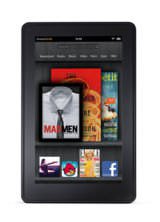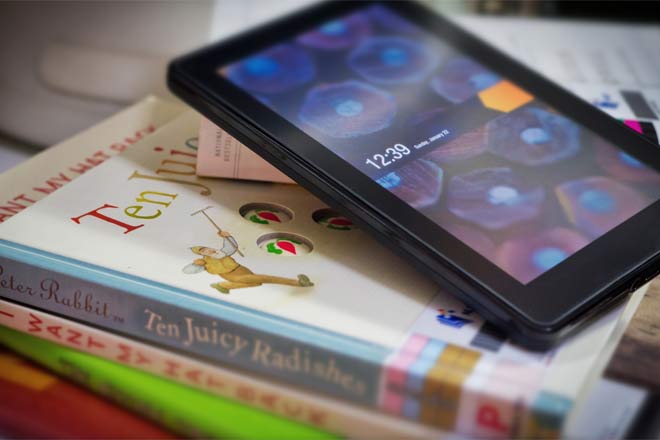This article compares Amazon's Kindle Fire and Apple's iPad 2 tablet computers.
Given the price differential as well as the difference in their specifications and hardware features, it could be argued that the two tablets are not really direct competitors. However, there are some common usage scenarios that both devices support equally well such as web browsing, email, and watching videos.
Comparison chart
| | Kindle Fire | iPad |
|---|---|---|
 |  | |
| Operating system | Android 2.3.3 | 1st generation: iOS 5.1.1, 2nd & 3rd & 4th generation: iOS 6.1.3 |
| Dimensions | 7.5" x 4.7" x 0.45" (190 mm x 120 mm x 11.4 mm) | 1st generation: 9.56 in (243 mm) (h), 7.47 in (190 mm) (w), 0.50 in (13 mm) (d), 2nd generation: 9.50 in (241 mm) (h), 7.31 in (186 mm) (w), 0.34 in (8.6 mm) (d), 3rd & 4th generation: 9.50 in (241 mm) (h), 7.31 in (186 mm) (w |
| Weight | 14.6 ounces (413 grams) | Wi-Fi model: 1.5 lb (680 g), Wi-Fi + 3G model: 1.6 lb (730 g), 2nd generation: 1.325 lb (601 g), 3rd generation Wi-Fi model: 1.44 lb (650 g), 3rd generation Wi-Fi + 4G model: 1.46 lb (660 g), 4th generation Wi-Fi model: 1.44 lb (650 g), 4 |
| Manufacturer | Amazon | Apple Inc. (depending on tablet) |
| Connectivity | USB 2.0 (micro-B connector), WiFi | Wi-Fi, 802.11 a/b/g/n, 1st & 2nd Generation, Bluetooth 2.1 + EDR, GSM models also include, UMTS / HSDPA, 850, 1,900, 2,100 MHz, GSM / EDGE, 850, 900, 1,800, 1,900 MHz, CDMA model also includes, CDMA/EV-DO Rev. A, 800, 1,900 MHz, 3rd Generation, Bluet |
| Display | 7" multi-touch gorilla glass display, 1024 x 600 at 169 ppi, 16 million colors. Multitouch. | 1st & 2nd generation: 1024 × 768 px 132 PPI 4:3 aspect ratio, 9.7 in (250 mm) diagonal, XGA, LED-backlit IPS LCD, 3rd & 4th generation: 2048×1536 px 264 PPI, Mini, 1,024x768 px 163 PPI, 7.9 in (200 mm) diagonal |
| Input | Touchscreen with multitouch | Multi-touch screen, headset controls, proximity and ambient light sensors, 3-axis accelerometer, digital compass, 2nd generation adds: 3-axis gyro |
| Type | Tablet computer | Tablet computer |
| Camera | No camera | 1st generation: None, 2nd generation: VGA Front-facing and 720p rear-facing, 3rd generation: VGA Front-facing and 5 million pixels rear-facing, 4th generation and mini: 720p Front-facing and 5 million pixels rear-facing |
| Power | rechargeable battery | Built-in rechargeable Li-Po battery, 25 W·h (90 kJ), 10hr life |
| Release date | November 15, 2011 | 1st generation: April 3, 2010 (Wi-Fi), April 30, 2010 (Wi-Fi + 3G), May 28, 2010 (International), 2nd generation: March 11, 2011 (United States), March 25, 2011 (International), 3rd generation: March 16, 2012, 4th generation and Mini: Nov |
| CPU | TI OMAP 4 (dual core) | 1st generation: 1 GHz ARM Cortex-A8, 2nd generation: 1 GHz dual-core ARM Cortex-A9, 3rd generation: 1 GHz dual-core ARM Cortex-A9, 4th generation: 1.4 GHz dual-core Apple Swift, Mini: 1 GHz dual-core ARM Cortex-A9 |
| Memory | 512MB RAM | 1st generation: 256 MB DDR RAM, 2nd generation: 512 MB DDR2 RAM, 3rd & 4th generation: 1024 MB DDR2 RAM, Mini: 512 MB DDR2 RAM |
| Developer | Amazon.com | Apple Inc. |
Hardware capabilities
Both devices offer a color touchscreen and a responsive user interface powered by a 1 GHz dual-core processor. At 14 ounces, the Kindle Fire is much lighter than the iPad (1.5 lbs) because the Kindle Fire has a smaller, 7-inch screen (1024 x 600 resolution) as compared to the iPad's 10-inch (1024 x 768) screen.
Notable hardware features missing in the Kindle Fire include camera (the iPad has two - one in the front and one at the back), Bluetooth, microphone and accelerometer. Another difference is storage capacity - the Kindle Fire offers only 8 GB of storage while the iPad offers 16, 32 and 64 GB models. The 3G version of the iPad also has cellular network connectivity and A-GPS.
The Kindle Fire does have a USB port, which the iPad does not have.
Special Features
Beyond the hardware specs, the two devices have important differences in the software that powers them. iPad runs Apple's iOS operating system and Kindle Fire runs a version of Google's Android 2.3 operating system that has been heavily customized by Amazon.
Apps
The iPad is a clear winner in terms of the sheer number of apps available for the device. All iPhone apps work on the iPad and there are hundreds of thousands of iPad-specific apps in Apple's store. Amazon's Android app store has fewer titles (roughly 10,000) and it's not clear how many of them would support Kindle Fire. Amazon's app store does, however, have a unique feature: user's can "test drive" an app in their browser for 30 minutes before they make a purchase decision.
Even the bundled apps are more versatile on the iPad. The Kindle Fire does not have a Calendar or Notes app. David Pogue called the Fire's e-mail app "serviceable". On the iPad all of these apps, as well as Facetime, Photos and Garage Band are fairly powerful apps for a tablet.
While the iPad's design lends itself to consumption much more easily than creation of digital content, that is even more so with the Kindle Fire.
Browser
The Amazon Kindle runs a new browser - Amazon Silk - which claims to be faster because it uses Amazon's cloud computing infrastructure (EC2) for processing.
Audio/Video communication
The Kindle Fire's lack of microphone and camera means that audio and video chat applications like Skype and Facetime will be unavailable.
Price
At $200, the Kindle Fire is a full $300 cheaper than the lowest-end iPad. This makes it a viable option for parents to purchase for their kids.
Content
Both Apple and Amazon aim to provide an end-to-end solution: the device, apps from a store, books, video (movies and TV series) and music. Amazon Prime ($79 per year) competes with Apple's iCloud ($25 per year) to enable cloud storage of purchased media (music, videos, books) for free. But Amazon Prime offers distinct advantages such as free 2-day shipping with Amazon purchases and free streaming of thousands of video titles (just like a Netflix subscription).
Expert Reviews
The iPad 2 garnered generally positive reviews for its responsiveness and speed, the content and apps available and for Apple's user interface. The Kindle Fire got mixed reviews upon launch. Among the pros, reviewers mentioned that the Kindle Fire is easy to use, the content and app ecosystem is well-integrated and "frictionless", and the Silk browser works very well. Amazon Prime members also get unlimited streaming from Amazon's library of TV shows and movies. Some of the cons were that the 7-inch size of the device was too small for some tablet functions, the software was buggy and sluggish at times, and the battery life and storage space were not enough. But on the whole, reviewers felt that for its price ($200), the Kindle Fire offered a lot of value.
CNN Review Video
Walt Mossberg (WSJ) Review Video
Kindle Fire vs iPad sales analysis (WSJ)




 Amazon MP3
Amazon MP3  Kindle Fire HD
Kindle Fire HD  Kindle
Kindle  Kindle 2
Kindle 2  Laptop
Laptop  MacBook
MacBook
Comments: Kindle Fire vs iPad